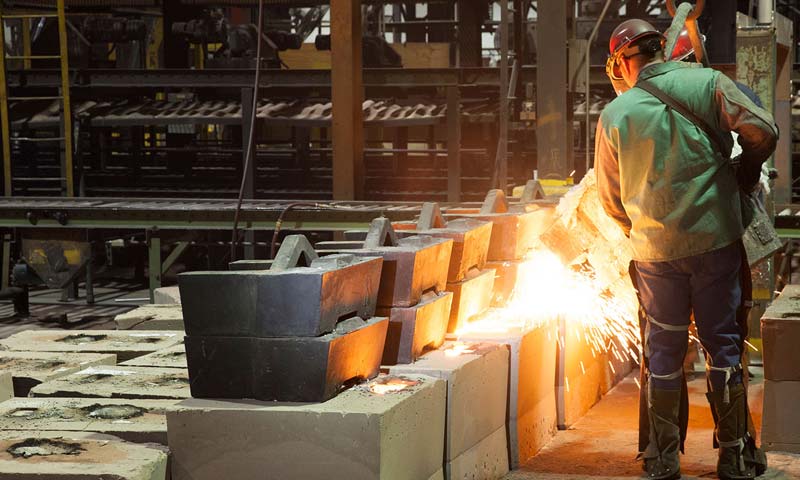1) Put the degreaser into the cleaning tank, and the degreaser adopts the following formula: a) 0.8% detergent + 99.2% tap water; b) 0.5%~1.0% washing powder + 99.5%~99% tap water.
2) Heat the prepared degreasing liquid to 20~25℃, then put it in the wax mold to degreasing, soak for 3~}5 minutes, and gently wipe the surface of the wax mold with soft material (sea surface, cotton cloth, etc.), especially wax Mold cavity.
3) The wax model after degreasing should be cleaned twice in clean water until there is no wax debris on the surface and put it in the pan.
4) During the degreasing and cleaning process, avoid bumps and damage the surface of the wax mold.
5) Self-inspection by the operator, random inspection by the team leader, and storage in the tray.
6) When the wax pattern is transferred, it must be re-sampled by the quality inspector. The number of wax patterns for each casting is> 20 pieces. After the inspection pass rate is> 95%, it is transferred to the module assembly sequence.
Wax stick operation process requirements
1) The pouring system, including sprue bars, cross runners, inner runners and risers. Its cross-sectional shapes are square, rectangular and round, ensuring that castings with no shrinkage, no shrinkage, and fine structure can be obtained. The quality of the assembly of the gating system has a great influence on the dimensional accuracy, surface finish, production efficiency and yield of the casting.
2) The wax liquid of the pouring system is generally recycled wax liquid. When using A1 mandrel to hang the wax, the temperature of the wax liquid should be controlled at 50±5℃. The thickness of each layer is 3~4mm (according to the process documents when special requirements are required), and then put it in water to cool. The wax immersion time depends on the thickness. The cold water tank should be mixed with a washing powder aqueous solution with a concentration of 0.5% to 0.8%.
3) The surface of the runner rod for wax hanging should be smooth and flat to avoid excessive wax flow.
4) The wax-hanging sprue stick should be placed in the tray, and it should be kept warm in winter to prevent freezing and cracking.
5) Perform self-check after wax hanging.
6) When pouring the sprue rod, it is poured according to the production operation plan. The surface of the sprue rod must be smooth, free of burrs and flashes. After pouring, it must be degreasing, cleaned, and marked (part number, quantity, operator) , Inspectors, production date and inspection status, etc.).
Wax mold assembly process requirements
1) Equipment and tools: 2kW disc resistance furnace, soldering iron, repair knife and caliper, etc.
2) Choose the height of the pressure head.
3) During the wax mold assembly process, the distance between two adjacent wax molds is 8-12mm, and the smaller distance is 6-8mm.
4) When welding wax mold and sprue rod, there must be a certain inclination angle to facilitate coating and sanding.
Stainless steel precision casting is not only suitable for various types of alloy casting, the size, precision and surface quality of the castings produced by the product are higher than other casting methods, and even some casting methods are difficult to cast and difficult to process. Both can be cast by its investment casting.
The current stainless steel precision casting technology has been practically applied in industrial production. At that time, the development of aviation jet engines required the manufacture of heat-resistant alloy parts with complex shapes such as impellers, blades, and nozzles, precise product dimensions, and smooth surfaces.
Heat-resistant alloy materials are difficult to machine, and the shape of the parts is complex, so other methods cannot be used to make them. It is necessary to find a new precision molding process, so many manufacturers learn from the ancient lost wax. Casting.
Stainless steel precision casting mainly improves materials and technology during the production process. Modern casting methods can obtain important developments on the basis of ancient technology. Therefore, the development of the aviation industry has also effectively promoted the application of such technology.
Stainless steel castings can be directly repaired by welding repair methods during use. When the product is repaired by its tungsten argon arc welding, its weld repair area and weld repair depth must meet its regulations. The product is welded The supplemented area refers to the area after expansion.
Stainless steel castings can not be welded more than three times at the same place. The distance between the castings on the edge of the weld zone, which includes the opposite weld zone, must not be less than the sum of the diameters of the two adjacent weld zones. After welding repairs, heat treatment is required in the original state.
Stainless steel castings need to be effectively tested for their mechanical properties after heat treatment. The area of the argon arc welding area in the casting must not be less than 2cm2. The equipment welding area distance is not effective 100 mm. It can be used without heat treatment, but a stainless steel casting There should be no more than 5 places.
Stainless steel castings must not have cracks and incomplete penetration in the welding area. Castings are allowed to have pores or inclusions with a larger diameter not greater than 2 mm and not exceeding 1/3 of the wall thickness in any welding area. One, the margin of the product is not 10 mm.
The material used in the processing of castings can be metal, sand or ceramics. In the process of use, the method of use will be different according to the requirements of its use. This method is called its Casting.
In the production process of castings, parts with more complicated shapes can be produced, especially the blanks with more complicated inner cavities. The adaptability of the whole product is very wide. Such products are metal materials frequently used in the industry and can be used. Casting.
In the process of processing, castings have relatively good requirements for casting quality, which will directly lead to the reduction of their machining allowances, so that the defects of the products will be reduced to a certain extent, so that air or Casting in a vacuum, which was considered a qualified heat-resistant steel precision casting, is now judged as a scrap.
In the actual production of castings, it is often necessary to effectively analyze the defects of the castings, and to find out the reasons for the defects purposefully, so that it is convenient to take measures to prevent them, and then effectively combine the actual conditions of the casting production, appropriately Draft technical requirements locally.
Silica sol precision casting can leave a small amount of machining allowance on the parts with higher requirements. In the process of processing, even some castings only leave polishing allowance and grinding, and can be used without mechanical processing.
The use of silica sol precision casting method can save its machine tool equipment and processing man-hours to a certain extent, which can greatly save its metal raw materials. Another advantage of investment casting can be to process complex castings of various alloys.
The processing technology of silica sol precision casting is relatively complicated and can not be controlled, and consumes materials in the processing process. Therefore, this processing method is very suitable for processing small parts with high precision requirements and complex shapes and difficult to process.
The first step in the production process of silica sol precision casting is to make investment molds. In the process of use, it is mainly used to form a model of the cavity in the refractory shell, so that castings with high dimensional accuracy and surface finish can be obtained.




 +86-13315766777
+86-13315766777


 Message
Message





